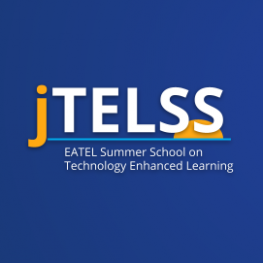Speakers
Maria Perifanou
University of Macedonia, GreeceFilippos Kolovos
University of Macedonia, GreecePolina Häfner
Karlsruhe Institute of Technology, GermanyAnastasios Economides
University of Macedonia, GreeceStart
23/05/2022 - 16:00
End
23/05/2022 - 17:30
Telepresence Robots in Education: From Theory to practice
Monday 23/05 16:00-17:30h
Outdoor Area B
Abstract.
The main goal of the workshop will be to elaborate remote telepresence technologies into modern educational methods. Authentic and game based learning via team collaboration will be the main activity, targeting the assessment of remote telepresence technologies in such educational frameworks, where one cannot be physically present, in order to participate either solely, or as part of a team. The focus will be the evaluation and hands-on experience on using telepresence robots in a game based learning environment, where two opposing teams will be engaged in a knowledge treasure hunt. The participants will be invited to form teams and to collaborate together in an educational game, where some members will be participating remotely via two telepresence robots, while others will be physically on site. Advantages, disadvantages, obstacles and benefits of the implementation of this technology in the educational realm will be evaluated and implementations onto alternative educational methods and applications will be discussed.
Needs Analysis
In the COVID-19 era, a lot of educational activities, where physical presence was important, took a lot of steps back. The incorporation of remote teleconference software applications in education, offered a temporary solution to this problem during the last two years. However, even if the pandemic is now slowly going into decay and most of the educational activities are resuming their traditional modus operandi, there is still the need to support remote presence and mobility for people not being able to attend, where attendance is mandatory. Although there is a technology framework to support remote presence in education, in this workshop we take it one step further, trying to explore past the simple “presence milestone”, where collaboration is necessary among the participants and not simply to be physically in the area. The students participating in the workshop will benefit from the following:
- They will be evaluating the telepresence robot technology in a collaborative and mobile manner in game and authentic learning organized in multiple teams.
- They will experience a new way of overcoming the mixed presence learning environment challenge, where remote and physical presence are overlapping and they will gain a point of view into its application benefits and obstacles.
- They will gain practical insight on how the telepresence robot technology will and can be implemented, in order to augment other educational fields and methods.
Learning Objectives
The participants will:
- Learn to operate a remote telepresence robot, while collaborating with other team members in a problem solving environment
- Learn how to use the benefits and how to overcome the obstacles of this technology via the traits that the telepresence robots have to offer (screen sharing, mobility, remote connection and operation, etc).
- Participate in a discussion on the future of this technology’s applications, involving interviews and brainstorming activities.
Pre-activities
No specific activities are necessary. There will be, however, an introductory educational video on the telepresence robot technology, where the students are invited to watch prior to the workshop. This will be beneficial, since the participants will already have familiarized themselves with this technology beforehand.
Session Description
10 mins: Break the ice and get to know each other. Brief description of how the workshop’s main activity, i.e. the educational game is going to be carried out and what are the objectives.
5 mins: Short presentation. There will be an introductory presentation briefly describing the telepresence robots capabilities and their way of operation
10 mins: Team forming. The participating members will be called to form at least two teams. The teams should be composed at least of two individuals, one of which will be operating the telepresence robot and the other will be participating physically in the game. There is no maximum limit on the teams’ participants.
30 mins: Game. The formed teams will compete on a treasure hunt educational game, where each team will have to collaboratively follow and answer a series of questions presented in the “open” area, until the final question. The team answering the final question first wins the game.
30 mins: Discussion. A discussion will take place amongst the participating team members. This step is planned to include brainstorming, interviews and general discussion as well as the submission of a questionnaire regarding their contribution on two basic things:
- Their experience in the educational method they participated, pointing out the pros and cons and how these can be improved
- Their views and ideas on other educational methods and activities that the telepresence robot technology can be used
5 mins: Wrap up the session.
Please allow for some variation on the exact session step timing and application.
Post – Activities
There will be a feedback evaluation questionnaire, to help us understand the impact value that the workshop had to the participants.
Literature recommendations:
Perifanou, M., Häfner, P., Economides, A. (2022). Users’ experiences and perceptions about telepresence robots in education. In: Proceedings EDULEARN, 14th annual International Conference on Education and New Learning Technologies, Palma de Mallorca, Spain, 4-6 July. IATED.
Perifanou, M., Galea, M., Economides, A.A., Wernbacher, T. & Häfner, P. (2022). A focus group study on telepresence robots in education. In: Proceedings EDULEARN, 14th annual International Conference on Education and New Learning Technologies, Palma de Mallorca, Spain, 4-6 July. IATED.
Wernbacher, T., Pfeiffer, A., Häfner, P., Buchar, A., Denk, N., König, N., DeRaffaele, C., Attard, A., Economides, A.A., & M. Perifanou (2022). TRinE: Telepresence robots in education. In: Proceedings of the 16th annual International Technology, Education and Development Conference (INTED) 2022, pp. 6514-6522, 7-8 March, IATED.
Ahumada-Newhart, V. and J.S. Olson, “Going to school on a robot: Robot and user interface design features that matter,” ACM Transactions on Computer-Human Interaction (TOCHI), 26(4), 1-28, 2019. DOI: 10.1145/3325210




